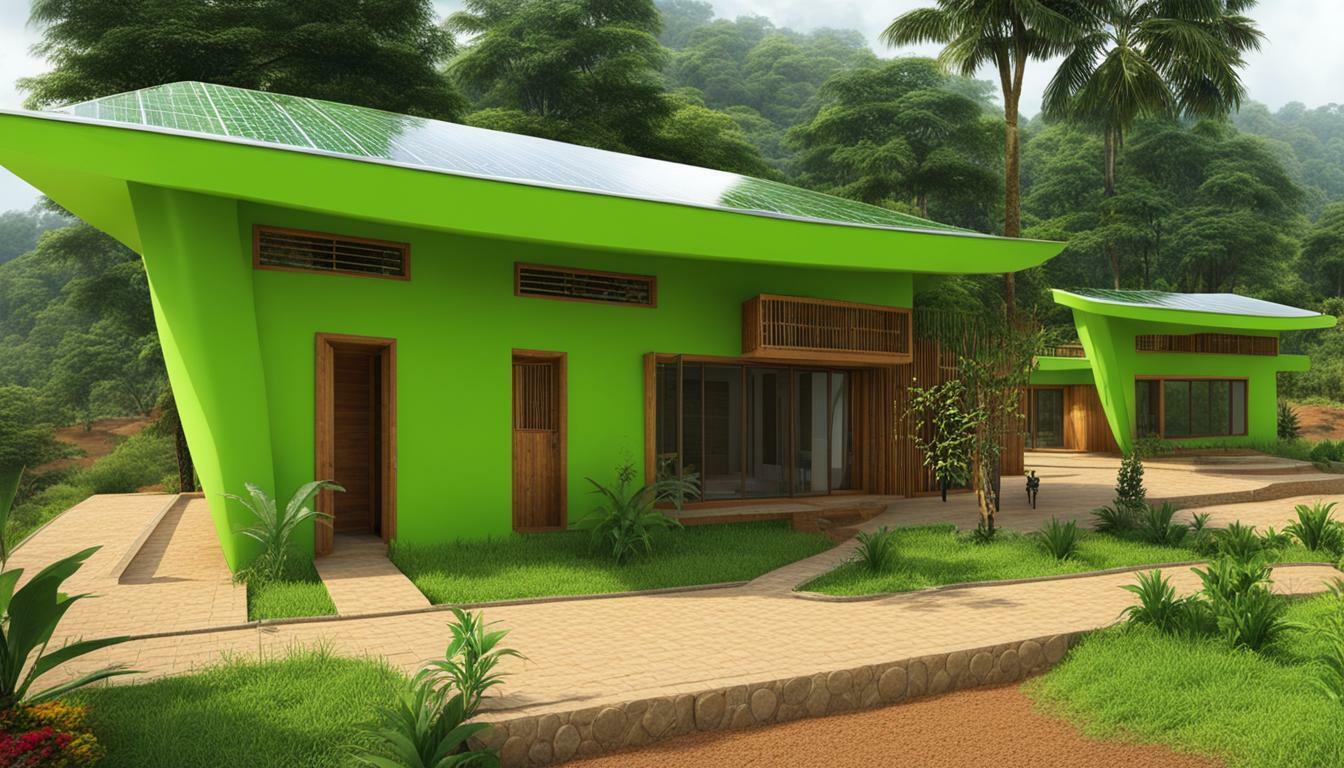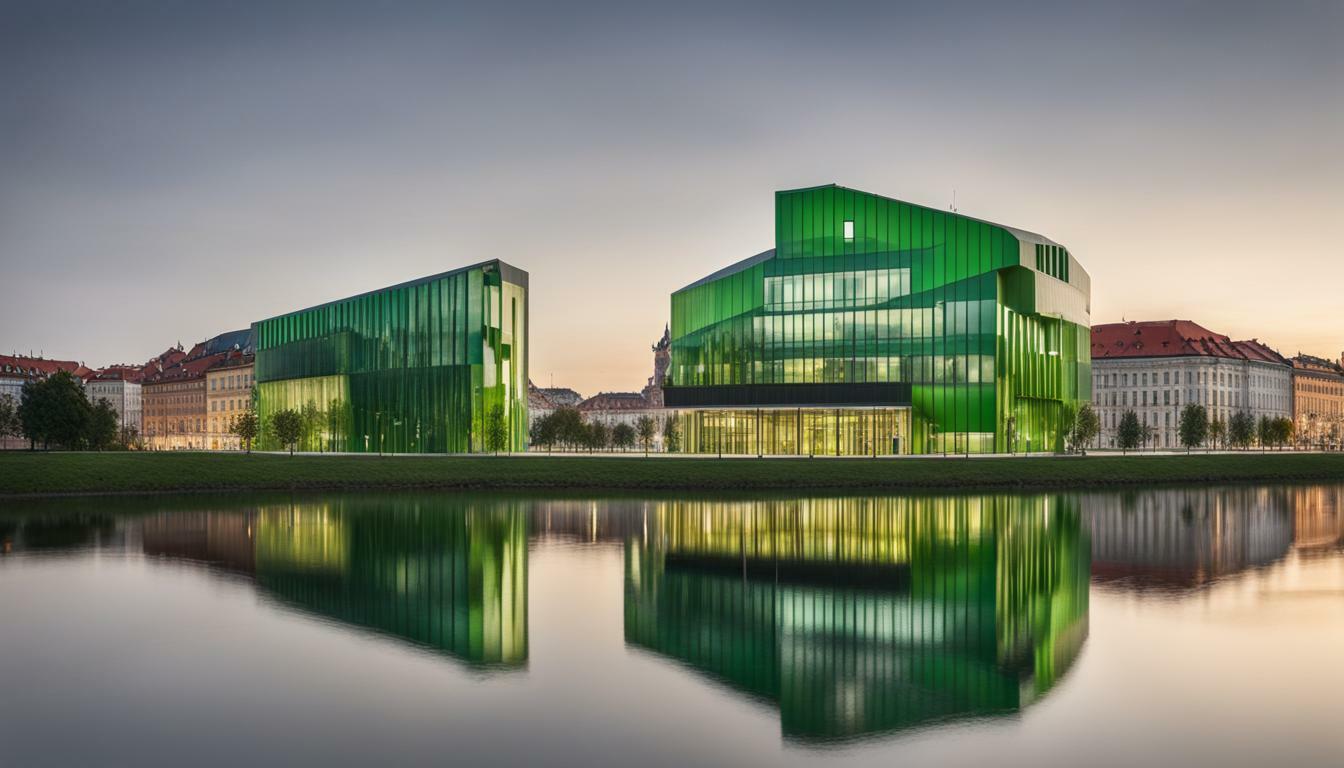Cyprus Green Building History
Cyprus has a long and rich history of sustainable architecture and construction practices. From early traditional techniques to innovative modern designs, Cyprus has embraced eco-friendly building techniques and sustainable development initiatives. As a result, the island has become a leader in the green building movement.
For many years, Cyprus has prioritized environmentally-conscious design and construction, recognizing the importance of creating a sustainable built environment. The growth of the green building movement in Cyprus can be attributed to the use of sustainable building materials, energy-efficient construction practices, and environmentally-friendly building design principles.
The commitment to sustainable development in Cyprus has played a significant role in shaping the green building evolution on the island. This has led to the emergence of sustainable construction innovations and the adoption of green building practices.
- Cyprus has a rich history of green building, embracing sustainable architecture and construction practices.
- The island has prioritized environmentally-conscious design and construction, recognizing the importance of creating a sustainable built environment.
- The use of sustainable building materials, energy-efficient construction practices, and environmentally-friendly building design principles have contributed to the growth of the green building movement in Cyprus.
- Cyprus’s commitment to sustainable development has led to the emergence of sustainable construction innovations and the adoption of green building practices.
- As Cyprus continues to prioritize sustainability, it sets an example for other regions to follow in creating a more environmentally-conscious built environment.
Early Beginnings of Sustainable Architecture
As we explore the history of sustainable architecture in Cyprus, it’s important to look at the early beginnings of this movement. Cyprus has a long tradition of incorporating energy-efficient and environmentally-friendly design principles, dating back to ancient times when resources were scarce and people needed to adapt to their surroundings.
One of the most notable examples of early sustainable architecture in Cyprus is the ‘pithouses’ built by the island’s first inhabitants. These homes were dug into the ground, providing natural insulation and protection from the harsh sun. The design of the pithouses also allowed for natural ventilation, keeping the interior cool and comfortable.

In more recent history, sustainable architecture in Cyprus started to gain momentum in the 1970s and 1980s. During this time, there was a growing awareness of the need to conserve energy and protect the environment. Architects and builders began to incorporate sustainable design principles into their projects, using local materials and traditional techniques to create energy-efficient and eco-friendly buildings.
Early Beginnings of Sustainable Architecture
“Cyprus has a long tradition of incorporating energy-efficient and environmentally-friendly design principles, dating back to ancient times when resources were scarce and people needed to adapt to their surroundings.”
The traditional architecture of Cyprus also played a significant role in the development of sustainable design practices on the island. The use of natural materials such as stone and clay helped to regulate temperature and humidity, while the design of buildings incorporated features such as courtyards and shading devices to provide natural cooling.
Today, sustainable architecture in Cyprus continues to evolve and adapt to new challenges and opportunities. Architects and builders are exploring innovative materials and technologies to create buildings that are not only energy-efficient and eco-friendly but also aesthetically pleasing and functional for modern living.
- SEO relevant keywords: sustainable architecture in Cyprus
Evolution of Energy-Efficient Construction Practices
In recent years, the construction industry in Cyprus has seen a significant shift towards energy-efficient and sustainable construction practices. This evolution has been driven by advancements in technology, innovation, and a growing awareness of the need to reduce carbon emissions and mitigate the impact of climate change.
One of the key sustainable construction innovations in Cyprus has been the incorporation of renewable energy systems. Solar power is a particularly popular choice, with many buildings utilizing photovoltaic panels to generate electricity. The use of smart technology has also become increasingly prevalent, with buildings equipped with sensors and automation systems to optimize energy consumption and minimize waste.
Efficient building materials have also played a crucial role in the evolution of energy-efficient construction practices in Cyprus. The use of insulation materials, such as expanded polystyrene (EPS), has helped to reduce energy consumption by improving thermal performance and reducing heat loss. Additionally, the use of low-emission materials, such as low volatile organic compound (VOC) paint, has contributed to improved indoor air quality, creating healthier and more comfortable living environments.
The evolution of energy-efficient construction practices in Cyprus has been driven by a combination of factors, including government regulations, market forces, and consumer demand for sustainable and environmentally-friendly building practices. As the construction industry continues to innovate and evolve, we can expect to see further advancements in sustainable construction and energy-efficient building practices in Cyprus.

As Cyprus continues to prioritize sustainability, there has been a significant shift towards environmentally-friendly building design principles. Eco-friendly building techniques prioritize energy efficiency, waste reduction, and the use of sustainable materials. Passive design strategies, natural ventilation, and green roofs are some of the techniques used to minimize the environmental impact of buildings.
Passive design strategies take advantage of natural resources such as sunlight, wind, and trees to regulate the temperature and lighting of a building. By strategically placing windows and using shading devices, passive solar design allows for natural heating and cooling. Natural ventilation relies on the movement of air through a building to cool it down, reducing the need for air conditioning. Additionally, green roofs provide insulation to buildings, reducing energy consumption, and absorbing rainwater, reducing runoff.
Implementing these eco-friendly building techniques brings numerous benefits to the environment, the occupants, and the economy. Energy-efficient buildings reduce greenhouse gas emissions and save resources. They promote better indoor air quality and improve the health and wellbeing of occupants. Moreover, they can be cost-effective in the long run, reducing operating costs for building owners.
Cyprus has taken significant steps towards promoting environmentally-friendly building designs, ensuring a sustainable built environment for future generations.

Cyprus has made significant strides in sustainable development over the years, with a strong commitment to creating a more environmentally-conscious built environment. The Cyprus Green Building movement has been a driving force in pushing for sustainable construction practices and promoting eco-friendly building design principles.
One of the main sustainable development initiatives in Cyprus is the National Strategy for Sustainable Development, which aims to promote economic growth while protecting the environment and preserving natural resources. The strategy encompasses various sectors, including energy, transport, agriculture, and tourism, with a focus on reducing greenhouse gas emissions and promoting renewable energy sources.
The government has also implemented regulations and incentives to promote sustainable construction practices. The Energy Performance of Buildings Directive requires new buildings to meet energy efficiency standards, and the government provides subsidies and tax breaks for the installation of renewable energy systems and energy-efficient equipment.
Non-governmental organizations have also played a crucial role in promoting sustainable development in Cyprus. The Cyprus Green Building Council, a non-profit organization, works to educate and advocate for sustainable construction practices and green building certifications. Community-driven projects, such as the Green Roof Project in Nicosia, aim to transform urban spaces into more sustainable and eco-friendly environments.
Overall, Cyprus has made significant progress in sustainable development and promoting the use of sustainable building materials and practices. With continued efforts and commitment to sustainability, Cyprus sets an example for other regions to follow in creating a more environmentally-conscious built environment.

Cyprus’s commitment to sustainable development extends to the use of sustainable building materials in construction. The construction industry is one of the largest consumers of natural resources, making it essential to prioritize the use of eco-friendly materials that minimize the impact on the environment.
Sustainable building materials in Cyprus include locally sourced materials, recycled materials, and innovative alternatives that promote resource efficiency and have a low carbon footprint. Using these materials not only reduces the dependence on non-renewable resources but also contributes to the overall sustainability of buildings.
| Examples of Sustainable Building Materials in Cyprus | Benefits |
|---|---|
| Bamboo | Fast-growing and renewable; high strength and durability |
| Recycled Glass | Eco-friendly alternative to conventional glass; energy-efficient and non-toxic |
| Clay Bricks | Energy-efficient; locally sourced; recyclable |
| Hempcrete | Low carbon footprint; excellent insulation properties; recyclable |
| Cellulose Insulation | Made from recycled materials; energy-efficient; non-toxic |
Using sustainable building materials in Cyprus not only benefits the environment but also has economic and social benefits. The use of locally sourced materials supports the local economy and promotes sustainable development practices. Additionally, sustainable building materials can improve indoor air quality, reduce energy costs, and increase the overall value of the building.
Overall, the use of sustainable building materials in Cyprus is essential in promoting the sustainability of the built environment. It is crucial for the construction industry to prioritize the use of eco-friendly materials for a more sustainable future.
Conclusion
In conclusion, Cyprus has a rich history of green building that has evolved over time.
The island has embraced sustainable architecture, energy-efficient construction practices, and eco-friendly building techniques. Cyprus’s commitment to sustainable development and the use of sustainable building materials has contributed to the growth of the green building movement on the island.
Setting an Example
As Cyprus continues to prioritise sustainability, it sets an example for other regions to follow in creating a more environmentally-conscious built environment. By promoting sustainable development initiatives, incorporating energy-efficient construction practices and materials, and utilizing eco-friendly building techniques, Cyprus is leading the way in designing and constructing buildings that have minimal impact on the environment.
It is encouraging to see the efforts of both government and non-governmental organizations in promoting sustainable development in Cyprus. The focus on reducing carbon emissions and increasing energy efficiency in the construction industry is a positive step towards a more sustainable future.
A Bright Future
As technology advances and new innovations emerge, Cyprus’s green building movement will continue to evolve and grow. Continued investment in sustainable construction practices and the adoption of environmentally-friendly building techniques will help to create a more sustainable built environment for future generations to enjoy.
Overall, Cyprus’s dedication to sustainability has made it a leader in green building. It is an exciting time for the construction industry in Cyprus, and the future looks bright for the continued growth of sustainable development and eco-friendly building practices.
FAQ
What is Cyprus Green Building History?
Cyprus Green Building History refers to the evolution of sustainable architecture, energy-efficient construction practices, and eco-friendly building techniques in Cyprus. It encompasses the growth of the green building movement, sustainable development initiatives, and the use of sustainable building materials on the island.
When did sustainable architecture begin in Cyprus?
Sustainable architecture in Cyprus has its early beginnings rooted in historical practices that prioritized energy efficiency and environmental considerations. Traditional techniques and designs that embraced sustainable principles have been passed down through generations.
How have energy-efficient construction practices evolved in Cyprus?
Energy-efficient construction practices in Cyprus have undergone significant developments and innovations. The incorporation of renewable energy systems, smart technology, and efficient building materials have revolutionized the construction industry, making buildings more sustainable and energy-efficient.
What are some eco-friendly building techniques used in Cyprus?
Cyprus has seen a rise in eco-friendly building techniques, such as passive design strategies, natural ventilation, and green roofs. These techniques prioritize environmental considerations and contribute to energy efficiency and indoor air quality.
What sustainable development initiatives are taking place in Cyprus?
Cyprus is committed to sustainable development, with government policies, regulations, and incentives promoting sustainable construction practices. Non-governmental organizations and community-driven projects also play a role in creating a more sustainable built environment on the island.
What are some sustainable building materials used in Cyprus?
In Cyprus, sustainable building materials are chosen to have a low carbon footprint and promote resource efficiency. Locally sourced materials, recycled materials, and innovative sustainable alternatives are available in the construction industry.








